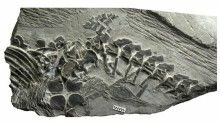
Fossil Shows Triassic-Era Sea Creature Gave Birth On Land

An extraordinary find of a fossil of 250-million-year-old air-breathing sea creature shows that it must have given birth on land, not in the sea as long assumed.
The fossil is of a mother chaohusaurus, which is believed to be a genus of ichthyosaur, who died giving birth. It shows the baby birthing headfirst.
From earlier fossil finds, scientists already knew that these Triassic-era predators gave live birth, but what they didn’t know was whether the earliest ichthyosaurs, who evolved from land-dwelling cousins, gave birth headfirst, like land mammals, or tail-first, like modern whales and dolphins do, an evolutionary adaptation to avoid suffocating the offspring underwater.
And, according to a statement from researchers, who published in the latest edition of PLOS ONE, the fossil (which shows three neonates in the womb, one in the process of being born) shows a head-first birth, so “live births in ichthyosaurs may have taken place on land, instead of in the water, as some studies have previously suggested,” according to Ryosuke Motani, a prehistoric marine reptile expert at the University of California, Davis who led the study.
Motani tells LiveScience: “This land-style of giving birth is only possible if they inherited it from their land ancestors. … They wouldn’t do it if live birth evolved in water.”
National Geographic writes:
“[New] research reveals that over the evolutionary trajectory of reproduction, reptiles veered back and forth between the two strategies before settling on egg-laying. Live birth in reptiles seems to have evolved more than 100 times in history. But there are many gaps in scientific knowledge surrounding the phenomenon in ancient sea reptiles.”
Comments
Related Posts
- Genetic 'atlas' shows just how much of a hodgepodge we all are
- 'The epic journey of our species': Ancient baby a direct ancestor of today's Native Americans, his DNA reveals
- Laser bombardment yields energy milestone
- Prehistoric cave paint finds its way to space
- Researchers Find Fossil of 505-million-year-old Burgess Shale at Kootenay National Park
Recent Posts
- How to add new words to iOS dictionary
- Touch ID patents reveal how Apple uses 'Secure Enclave' in iPhone 5s' A7 chip for fingerprint sensor
- WiFi 's data-free risks for terrorists and criminals
- Mobile phone on planes
- To extend the battery life on your iPhone, iPad and Android
- Google Glass Development Kit (GDK)
- Back Up data on Android Smartphone
- What is Google Glass?
- WhatsApp iOS 7 update of fancy design on German YouTube channel
- Jury's decision 290 million dollar fine about the patent litigation between Samsung and Apple
- A New Application; SNAPCHAT is Wanted to Buy BY GOOGLE AND FACEBOOK
- Apple Buys Action Sensor Maker PrimeSense
- November 25th International Day for the Elimination of Violence Against Women
- Potato Power Could Light the World But How??
- Could be doomsday for Giants
- About Us
- Authors
- Contact
- Privacy Policy
- RSS
- | @ Women Citizen
